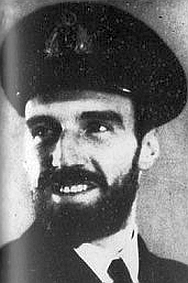Wanklyn, Malcolm David
- Date of birth:
- June 28th, 1911 (Calcutta, India)
- Date of death:
- April 14th, 1942 (Gulf of Tripoli, Mediterranean)
- Buried on:
- Portsmouth Naval Memorial
- Nationality:
- British
Biography
Do you have more information about this person? Inform us!
- Period:
- Second World War (1939-1945)
- Rank:
- Lieutenant-Commander
- Unit:
- Royal Navy
- Awarded on:
- March 3rd, 1943
"On the evening of the 24th of May, 1941, while on patrol off the coast of Sicily, Lieutenant-Commander Wanklyn, in command of His Majesty's Submarine Upholder, sighted a south-bound enemy troop-convoy, strongly escorted by Destroyers.The failing light was such that observation by periscope could not be relied on but a surface attack would have been easily seen. Upholder's listening gear was out of action. In spite of these severe handicaps Lieutenant-Commander Wanklyn decided to press home his attack at short range. He quickly steered his craft into a favourable position and closed in so as to make sure of his target. By this time the whereabouts of the escorting Destroyers could not be made out. Lieutenant-Commander Wanklyn, while fully aware of the risk of being rammed by one of the escort, continued to press on towards the enemy troop-ships. As he was about to fire, one of the enemy Destroyers suddenly appeared out of the darkness at high speed, and he only just avoided being rammed. As soon as he was clear, he brought his periscope sights on and fired torpedoes, which sank a large troop-ship. The enemy Destroyers at once made a strong counterattack and during the next twenty minutes dropped thirty-seven depth-charges near Upholder.The failure of his listening devices made it much harder for him to get away, but with the greatest courage, coolness and skill he brought Upholder clear of the enemy and safe back to harbour. Before this outstanding attack, and since being appointed a Companion of the Distinguished Service Order, Lieutenant-Commander Wariklyn had torpedoed a tanker and a merchant vessel. He has continued to show the utmost bravery in the presence of the enemy. He has carried out his attacks on enemy vessels with skill and relentless determination, and has also sunk one Destroyer, one U-boat, two troop-transports of 19,500 tons each, one tanker and three supply ships. He has besides probably destroyed by torpedoes one Cruiser and one Destroyer, and possibly hit another Cruiser. "
Lieutenant-Commander Wanklyn was killed on 14 April 1942 near Tripoli.
Malcolm David Wanklyn, seaman's buriel in the Mediterranean.
Name on Portsmouth Naval Memorial, Great Britain.
- Period:
- Second World War (1939-1945)
- Rank:
- Lieutenant Commander
- Unit:
- H.M.S. Upholder
- Awarded on:
- September 2nd, 1941
Citation:
"For skill and enterprise in successful submarine patrols."
"For skill and enterprise in successful submarine patrols."
- Period:
- Second World War (1939-1945)
- Rank:
- Lieutenant Commander
- Awarded on:
- August 25th, 1942
"For gallant and distinguished services in successful submarine patrols in H.M.S. Upholder."
Second DSO awarded posthumously as a bar for on the ribbon of the first DSO.
- Period:
- Second World War (1939-1945)
- Rank:
- Lieutenant Commander
- Awarded on:
- August 25th, 1942
"For gallant and distinguished services in successful submarine patrols in H.M.S. Upholder"
Third DSO awarded poshumously as second bar for on the ribbon of the first DSO.
Sources
- Photo 1: Wikipedia.org
- Photo: Wikipedia.org
- - Third Supplement to The London Gazette Issue 35382 published on the 12 December 1941
- Supplement to The London Gazette Issue 35261 published on the 29 August 1941
- Third Supplement to The London Gazette Issue 35679 published on the 21 August 1942
- Victoria Cross Reference
- The Register of the Victoria Cross - published by This Engeland 1997 - ISBN 0906324270
- Special thanks to Iain Stewart from The History of the Victoria Cross





